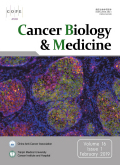- 钛学术文献服务平台 \
- 学术期刊 \
- 医药卫生期刊 \
- 肿瘤学期刊 \
- 癌症生物学与医学(英文版)期刊 \
CD13 inhibition augments DR4-induced tumor cell death in a p-ERK1/2-independent manner
CD13 inhibition augments DR4-induced tumor cell death in a p-ERK1/2-independent manner
基本信息来源于合作网站,原文需代理用户跳转至来源网站获取
摘要:
Objective:Death receptor 4 (DR4; TRAIL-R1) critically mediates extrinsic apoptosis cascades via binding to TNF-related apoptosis-inducing ligand (TRAIL). However, intrinsic and/or acquired resistance are observed in the clinical application of TRAIL. The aim of this study was to investigate the function and molecular mechanism of CD13 in the TRAIL/DR4 pathway against tumor cells, and provide a new strategy for improving therapeutic efficacy or overcoming TRAIL-resistance. Methods:TRAIL protein was expressed as a secretory protein in a Pichia pastoris expression system and was isolated and purified by affinity chromatography. The cell viability and apoptosis were evaluated with MTT (thiazolyl blue tetrazolium bromide) assays and annexin V-FITC/PI staining with flow cytometry analysis, respectively. Western blot analysis was used to detect the levels of the indicated proteins in tumor cells. DR4 degradation or stability was examined with cycloheximide chase assays, and cell surface DR4 was assessed with flow cytometric analysis after staining with a FITC-conjugated antibody. The effects of cell migration were determined with Transwell and gelatin zymography assays. A xenograft nude mouse model was used to detect the anti-tumor effect in vivo, and the proliferation in tumor tissues was examined with immunohistochemical staining. Results:CD13 inhibition potently sensitized tumor cells to TRAIL-induced killing, including proliferation inhibition, increased apoptosis, and migration suppression. In addition, the inhibition of CD13 elevated both total cellular expression and cell surface DR4 through stabilizing DR4 by suppressing its degradation. DR4 siRNA attenuated the enhanced anti-tumor effects of TRAIL plus CD13 inhibition. Interestingly, these phenomena were p-ERK1/2 independent, although p-ERK1/2 down-regulation was tightly correlated with the cooperation of TRAIL and CD13 inhibition. Moreover, a synergistic decrease in tumor growth was surprisingly achieved in the xenograft model by treatment of TRAIL with a CD13 inhibitor (**P < 0.01, CDI = 0.47). Conclusions:CD13 inhibition cooperates with TRAIL in enhancing DR4-mediated cell death, through the up-regulation and stabilization of DR4 in a p-ERK1/2-independent manner. Thus CD13 inhibition has emerged as an effective strategy for TRAIL/DR4-based therapy.

推荐文章
重组CD13单链抗体和蝎毒素多肽AGAP融合蛋白真核表达及对NB4细胞的靶向杀伤作用
东亚钳蝎
蝎毒活性肽
抗肿瘤缬精甘肽
CD13单链抗体
融合蛋白
子宫内膜样腺癌组织中 p-ERK1/2的表达变化及意义
子宫肿瘤
细胞外信号调控激酶
免疫组化
鼻咽癌组织中 ERK1/2、p-ERK1/2和 MMP-9蛋白的表达变化及其相关性
鼻咽癌
细胞外调节蛋白激酶1/2
磷酸化细胞外调节蛋白激酶1/2
基质金属蛋白酶9
辛伐他汀改善大鼠心肌梗死后心室重塑与p-ERK1/2的关系
辛伐他汀
心肌梗死
心室重塑
细胞外信号调节激酶1/2
内容分析
关键词云
关键词热度
相关文献总数
(/次)
(/年)
文献信息
| 篇名 | CD13 inhibition augments DR4-induced tumor cell death in a p-ERK1/2-independent manner | ||
| 来源期刊 | 癌症生物学与医学(英文版) | 学科 | |
| 关键词 | |||
| 年,卷(期) | 2021,(2) | 所属期刊栏目 | ORIGINAL ARTICLE |
| 研究方向 | 页码范围 | 569-586 | |
| 页数 | 18页 | 分类号 | |
| 字数 | 语种 | 英文 | |
| DOI | 10.20892/j.issn.2095-3941.2020.0196 | ||
五维指标
引文网络
引文网络
二级参考文献 (0)
共引文献 (0)
参考文献 (32)
节点文献
引证文献 (0)
同被引文献 (0)
二级引证文献 (0)
1999(2)
- 参考文献(2)
- 二级参考文献(0)
2000(2)
- 参考文献(2)
- 二级参考文献(0)
2001(2)
- 参考文献(2)
- 二级参考文献(0)
2002(1)
- 参考文献(1)
- 二级参考文献(0)
2003(1)
- 参考文献(1)
- 二级参考文献(0)
2004(1)
- 参考文献(1)
- 二级参考文献(0)
2005(2)
- 参考文献(2)
- 二级参考文献(0)
2008(2)
- 参考文献(2)
- 二级参考文献(0)
2009(1)
- 参考文献(1)
- 二级参考文献(0)
2011(3)
- 参考文献(3)
- 二级参考文献(0)
2012(2)
- 参考文献(2)
- 二级参考文献(0)
2013(1)
- 参考文献(1)
- 二级参考文献(0)
2014(1)
- 参考文献(1)
- 二级参考文献(0)
2015(3)
- 参考文献(3)
- 二级参考文献(0)
2016(2)
- 参考文献(2)
- 二级参考文献(0)
2017(1)
- 参考文献(1)
- 二级参考文献(0)
2018(2)
- 参考文献(2)
- 二级参考文献(0)
2019(3)
- 参考文献(3)
- 二级参考文献(0)
2021(0)
- 参考文献(0)
- 二级参考文献(0)
- 引证文献(0)
- 二级引证文献(0)
引文网络交叉学科
相关学者/机构
期刊影响力
癌症生物学与医学(英文版)
主办单位:
中国抗癌协会
出版周期:
季刊
ISSN:
2095-3941
CN:
12-1431/R
开本:
16开
出版地:
天津市河西区体院北环湖西路天津市肿瘤医院C座综合楼三楼
邮发代号:
6-173
创刊时间:
2004
语种:
eng
出版文献量(篇)
1054
总下载数(次)
0
总被引数(次)
2230
期刊文献
相关文献
推荐文献
- 期刊分类
- 期刊(年)
- 期刊(期)
- 期刊推荐
癌症生物学与医学(英文版)2022
癌症生物学与医学(英文版)2021
癌症生物学与医学(英文版)2020
癌症生物学与医学(英文版)2019
癌症生物学与医学(英文版)2018
癌症生物学与医学(英文版)2017
癌症生物学与医学(英文版)2016
癌症生物学与医学(英文版)2015
癌症生物学与医学(英文版)2014
癌症生物学与医学(英文版)2013
癌症生物学与医学(英文版)2012
癌症生物学与医学(英文版)2011
癌症生物学与医学(英文版)2010
癌症生物学与医学(英文版)2009
癌症生物学与医学(英文版)2008
癌症生物学与医学(英文版)2007
癌症生物学与医学(英文版)2006
癌症生物学与医学(英文版)2005

 免费查重
免费查重










